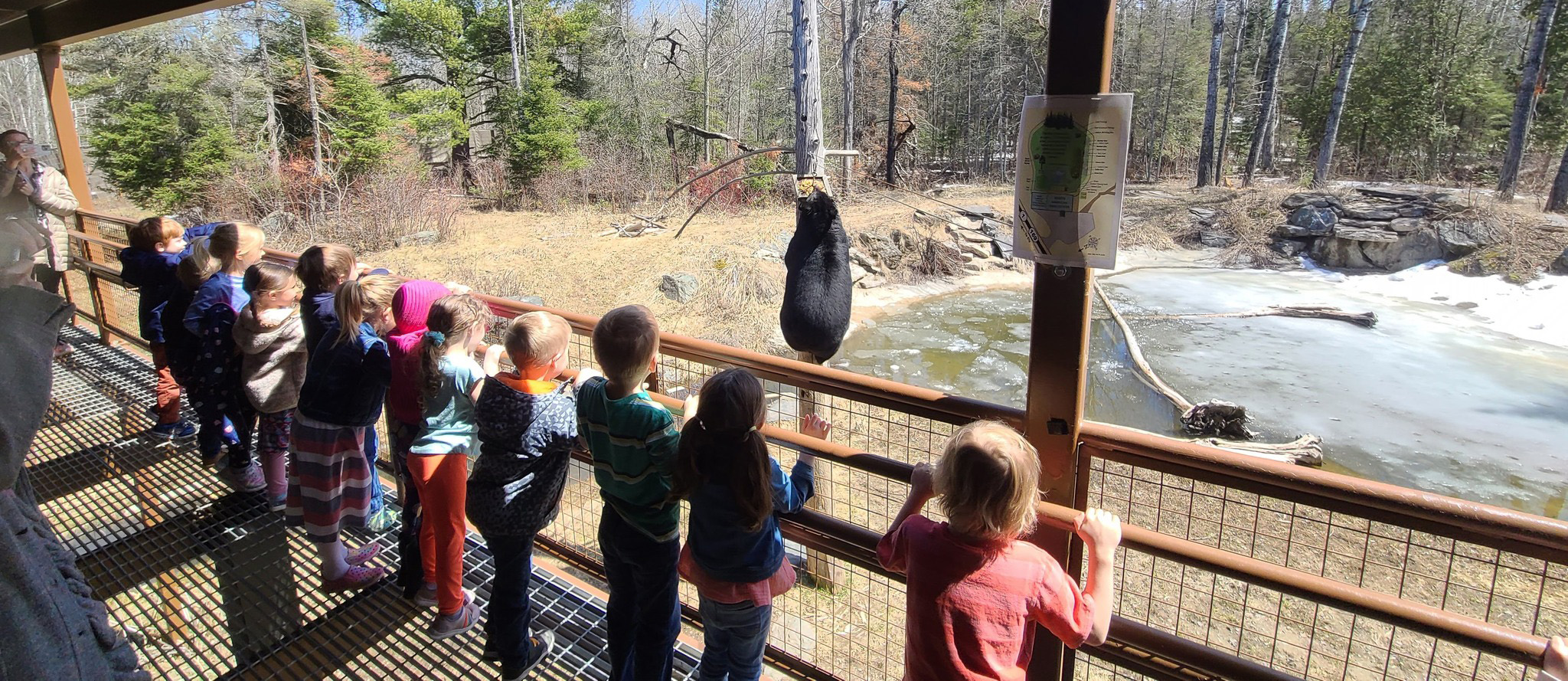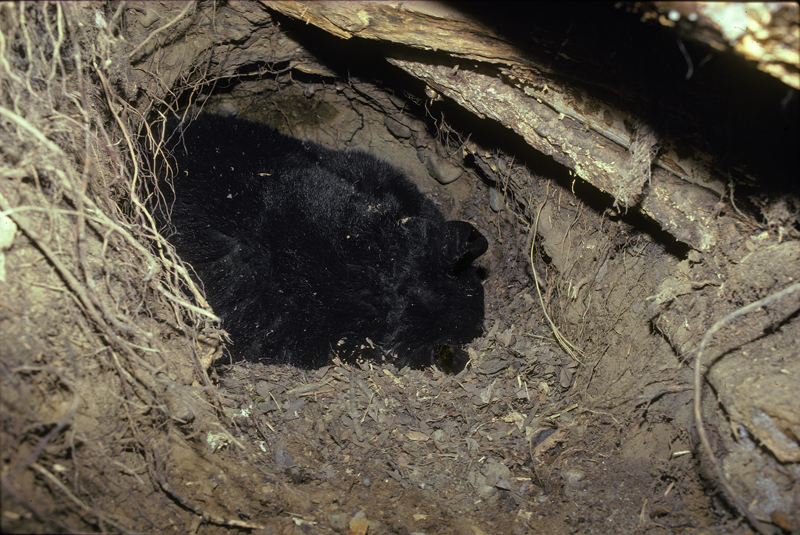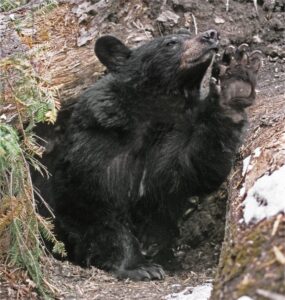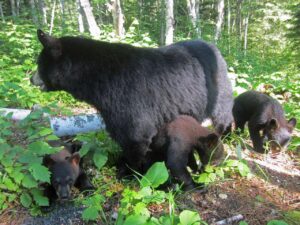

5 Stages of Activity and Hibernation
The annual cycle of black bear activity and hibernation has five stages:
1. hibernation
2. walking hibernation
3. normal activity
4. hyperphagia
5. fall transition

Bear in den
The stages differ in biochemistry, physiology, appetite, and level of activity. The onset and duration of the stages are genetically programmed to fit regional norms of food availability, which differ across America.
For example, around Ely, fall food is scarce, so bears begin hibernating in September or October and remain in dens for 6 or 7 months until April. If supplemental food is provided to these bears in fall, they abandon it to begin hibernating on time, as they are genetically programmed to do. Bears around Ely usually continue hibernating through winter thaws.

Spring stretch
The activity schedule is very different in eastern North America where acorns, hickory nuts, beech nuts, and other foods become available in fall and some foods remain available all winter. Bears there are genetically programmed to delay hibernation until late November or December and hibernate less than 5 months. Hibernation there is typically not as deep, and some bears emerge to forage during winter thaws. Food sometimes remains available throughout winter there, and some bears continue foraging throughout winter.
Experimental studies with captive bears revealed the following:

Mother and cubs
Stage 1— Hibernation of study bears in close dens is continuous dormancy with distinct decreases in heart rate and metabolic rate. They use up to 4,000 kcal per day, mainly body fat, and do not eat, drink, urinate, or defecate. They reduce oxygen consumption and metabolic rate to a little as 25% of summer rates and breathe once per 15 to 45 seconds. Heart rate can drop periodically to 8-21 beats per minute, and blood flow to skeletal muscle, particularly the legs, can be reduced by 45% or more, making some bears slow to become active in winter. Blood perfusion rates of peripheral tissues can fall below levels needed for aerobic metabolism in humans. However, wild mothers in open dens maintain near normal body temperature (high 90’s Fahrenheit), ingest their cubs’ urine and feces. They also lick up drops of meltwater, eat snow and icicles, urinate, and defecate.

Bear eating crabapple
Stage 2—Walking hibernation is the 2-3 weeks following emergence when metabolic processes adjust to normal summer levels. During walking hibernation, bears voluntarily eat and drink less than they will later during normal activity. They also excrete less urine, nitrogen, calcium, phosphorus, and magnesium.
Stage 3—Normal activity typically lasts from green-up in spring to the onset of hyperphagia in midsummer or fall, depending upon region. During this stage, bears with unlimited food eat 5,000 to 8,000 kcal per day. If they are denied water and food during this stage, they cannot duplicate hibernation responses. Instead, they become dehydrated, utilize muscle for energy, and accumulate nitrogenous wastes in the blood, which can be fatal.

Bear by den
Stage 4—Hyperphagia is a period of excessive eating and drinking to fatten for hibernation. Black bears with unlimited food and water ate 15,000 to 20,000 kcal per day and drank several gallons. Large amounts of water are needed to process the large amounts of food and rid the body of nitrogenous waste. Daily urine volumes for two bears were 2-4 gallons (8-16 liters). Nitrogen losses were 2.4 to 3.7 ounces (69-104 grams) (Nelson et al. 1983).
Stage 5—Fall transition is a period after hyperphagia when metabolic processes change in preparation for hibernation. Bears voluntarily eat less but continue to drink to purge body wastes. They become increasingly lethargic, resting 22 or more hours per day, often near water. Active heart rates fall from 80-100 per minute to 50-60 per minute, and sleeping heart rates fall from 66-80 per minute to less than 22 per minute.
References:
Folk, G. E., M. A. Folk, and J. G. Minor. 1972. Physiological condition of three species of bears in winter dens. Ursus 2: 107-125.
Folk, G. E., A. Larson, and M. A. Folk. 1976. Physiology of hibernating bears. Ursus 3:373-380.
Guyton, A. C. 1981. Textbook of medical physiology. Sixth ed. W. B. Saunders Co., Philadelphia, Pennsylvania, 1,074 pp.
Nelson, R. Al, G. Edgar Folk, Jr, E. W. Pfeiffer, John J. Craighead, C. J. Jonkel, and D. L. Steiger. 1983. Behavior, biochemistry, and hibernation in black, grizzly, and polar bears. Ursus 5:284-290.
Rogers, L. L., and S. C. Durst. 1987. Evidence that black bears reduce peripheral blood flow during hibernation. J. Mammal. 68(4):872-875.
Watts, P. D. et al. 1981. Mammalian hibernation and the oxygen consumption of a denning black bear. Comparative Biochemistry and Physiology A. Comparative Physiology 69:121-123.
We are a 501(c)(3) non-profit that relies entirely on the support of visitors, merchandise sales and people like you. We do not receive any state or federal funding.
Help support our mission.
Donate Now